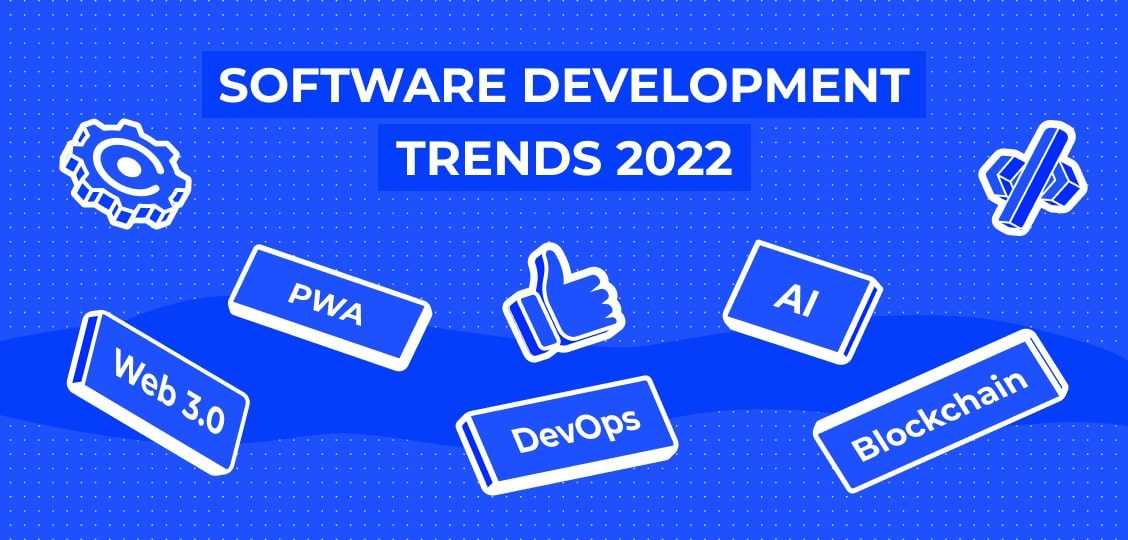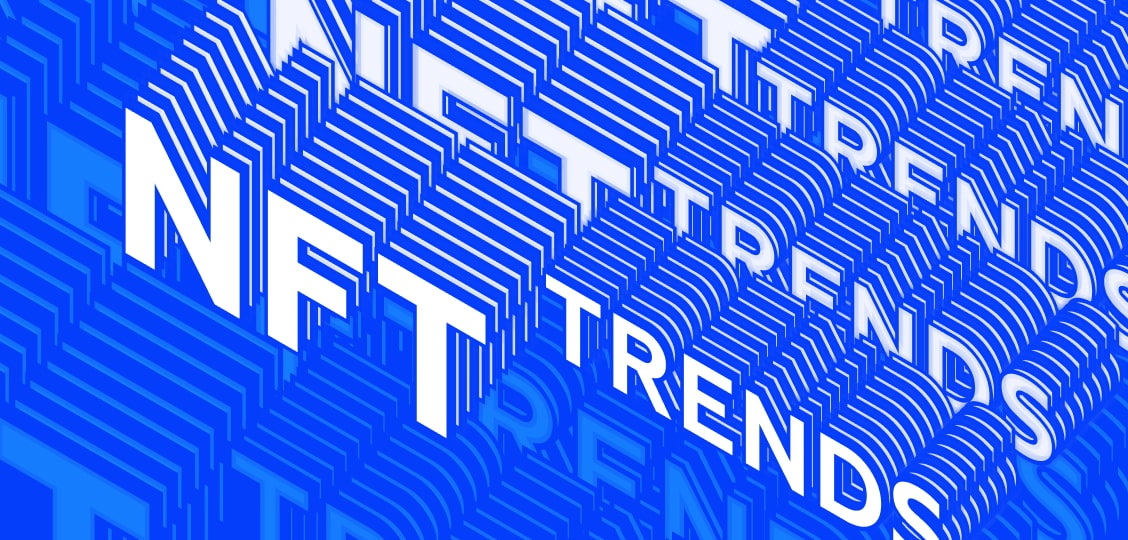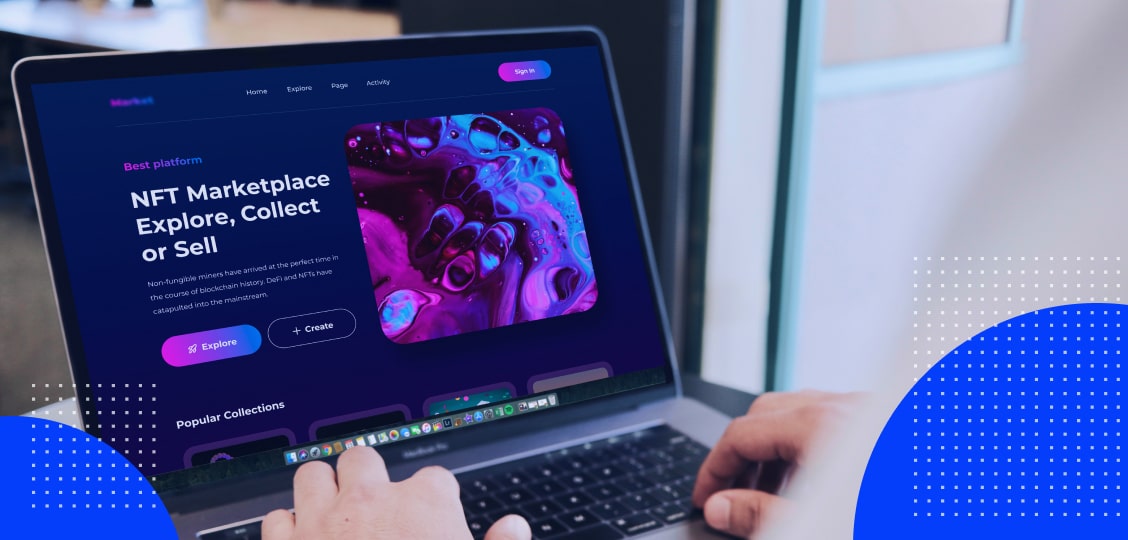Top NFT trends that will dominate the market in 2022
Explore the key NFT trends for 2022 to find out how you can generate revenue with non-fungible token marketplaces.

Using software products and technological innovations, companies can resolve a variety of challenges, for instance, automate manual tasks, improve employee productivity, minimize customer churn, and digitize paper-based workflows.
With the knowledge of the recent technology trends, you can find out how you can achieve business objectives, reduce expenses, and gain a competitive edge. Even if you currently do not have visible issues, you can find opportunities to increase revenue.
In this article, our experts have described the top software development trends for 2022 to help you get ideas for a software project and explore some best engineering practices. Have a look.
Web 3.0, also known as “The Decentralized Web”, is one of the game-changing trends in software development for 2022. In fact, Web 3.0 is considered to be the next phase of the World Wide Web. While Web 1.0, which is the first version of the Internet, represents the era of static web pages, Web 2.0 comprises user-generated content, big data, and advertising. In both versions of the Internet, the data is stored on centralized servers.
Web 3.0, in turn, is based on the blockchain distributed database and includes a variety of components such as cryptocurrencies, decentralized autonomous organizations (DAOs), and non-fungible tokens. As everything on the Internet will be held on the blockchain decentralized ledger, data will not be controlled by any individual entity.
This means that people will be able to make payments, publish posts, leave comments, download and like digital content, without companies knowing their identity and gathering personal information. That is why Web 3.0 is said to be a potential solution to Internet domination by big tech corporations that collect massive arrays of user data.
KPMG reports that now consumers are especially concerned about data privacy. According to the survey, 62% of business leaders claim that their organizations should make more of an effort to enforce data protection. Experts revealed that 86% of the US general population are increasingly worried about data confidentiality, 40% do not trust institutions to ethically use their information, whilst 30% are not likely to share personal data. In the new era of Web 3.0, users will have more control over their data, content, assets, and intellectual property, leading to considerably increased trust between vendors and customers.
Blockchain is among the key technology trends of 2022. The Insight Partners firm forecasts that the global blockchain market size will climb from $4.93 billion in 2021 to $227.99 billion by 2028, progressing at a compound annual growth rate (CAGR) of 72.9% during the indicated period.
Representing the decentralized distributed ledger, blockchain can transform the way institutions manage and protect data, certifications, intellectual property, tangible and digital assets. Based on cryptographic algorithms, the technology has a range of use cases that go beyond finance. For example, blockchain can allow businesses and individuals to track the origin of goods, vital to preventing the counterfeit of jewelry, historically valuable artifacts, artworks, museum pieces, and pharmaceuticals.
By employing blockchain, logistics companies can achieve supply chain traceability. To learn more about using blockchain in the logistics domain, read our article on this topic. In healthcare, organizations can safeguard medical data, control access to information, and minimize paperwork.
According to Deloitte’s 2021 survey, 80% of respondents state that their sectors will receive new revenue sources from blockchain, crypto solutions, and digital assets. Fortune Business Insights found that the banking industry is leading in blockchain software adoption, succeeded by telecommunications, media and entertainment, manufacturing, healthcare and life science, as well as retail. Experts predict that retail and consumer goods will register the highest CAGR between 2022–2029.
It is worth noting that due to blockchain, the world has witnessed the emergence of non-fungible tokens (NFTs), which are unique non-interchangeable units—images, paintings, audio records, videos, 3D models, etc.—that can be sold and traded.
Comprising a set of practices that combine software development (Dev) and IT operations (Ops), DevOps is among the fundamental software engineering trends for 2022 and beyond. DevOps encompasses a range of practices that aim to speed up software project delivery and enhance product quality, for example, continuous integration/delivery (CI/CD), system performance monitoring, infrastructure as code, microservices, communication and collaboration. It is worth pointing out that some DevOps aspects originated from the Agile methodology.
With the view to streamline and integrate processes between IT and development teams, DevOps allows businesses and institutions to create, test, and deploy applications much faster. According to the report of DORA (DevOps Research and Assessment), teams that employ DevOps manage to:
DevOps teams often utilize so-called intelligent observability. With the growing number of IT assets, apps, and data being migrated to the cloud, infrastructure becomes more complex and prone to vulnerabilities. In an enterprise system, assessing risks and detecting anomalies is crucial to prevent issues and ensure downtime-free operation.
Employing intelligent observability powered by artificial intelligence (AI), DevOps professionals can monitor IT infrastructure, timely recognize potential threats, and track how every system part interacts with each other. What’s more, machine learning can provide companies with recommendations on how to improve the existing infrastructure.
As DevOps provides a lot of benefits such as scalability, high availability, resilience, and security, the worldwide Development and Operations market is gaining momentum. Fortune Business Insights reports that the DevOps market will spike from $3,709.1 million in 2018 to $14,969.6 million by 2026, showcasing a CAGR of 19.1%.
Organizations across various industries use DevOps, involving Amazon, Etsy, Capital One, Google, Netflix, Frontier, and Alphapoint. To learn more about this model, read our article: “How to automate software development. Top 5 benefits of DevOps for business”.
In 2022, we expect to see the rise of applications that have a microservices architecture. In this architectural model, software engineers develop a system as a set of small, autonomous, loosely coupled services, each built around a specific task or feature, for instance, reporting, data analytics, in-app messaging, invoicing, order management.
A loose coupling nature contributes to improved scalability, high availability, and fault tolerance. Since each service can be created, deployed, and tested independently, companies do not have to rewrite or upgrade the whole platform when delivering new functionality or introducing changes.
Coming up with multiple advantages, microservices are expected to remain one of the top software development trends in 2022. The IBM survey of 2021 revealed that 78% of organizations utilizing this architectural style would increase their investment in microservices development.
IBM also found that 56% of enterprises that did not employ microservices were likely to adopt them within the next few years. In the future, 59% of apps are expected to be developed with microservices. Furthermore, IBM reported that 87% of participants agree that the use of microservices is worth their expenses and effort.
Concerning the benefits of a microservices architecture, 30% of respondents reported having higher customer satisfaction and retention rates, 29% stated they managed to enforce the security of customer data and reduce time to market, 28% said they could enhance system performance and overall quality. On top of that, 27% of microservices users achieved the flexibility to scale resources up or down depending on business needs. Additionally, 26% were able to enforce application security and raise developer productivity.
Traditionally, organizations acquired licensed software solutions, configured infrastructure on-premise, as well as purchased and installed hardware to build applications. As a consequence, enterprises had to set up servers, scale resources, and maintain systems on their own, which was costly and time-consuming. With the emergence of cloud computing, companies became able to address these challenges.
Being one of the top software development trends for 2022, cloud computing is the on-demand availability of computing services that include servers, databases, networking, software, analytics, and intelligence over the Internet.
Cloud computing allows businesses to enable data backup, disaster recovery, and data processing in real time while automating app deployment, ensuring scalability, and facilitating infrastructure maintenance. When an institution applies a cloud-first approach, it can enforce data security, improve developer productivity, and significantly reduce expenses.
By implementing a cloud-first strategy during the COVID-19 pandemic, organizations became able to quickly adjust to new realities. With cloud-first models, many brands established remote workflows and optimized costs. Thanks to this, they built resilience, vital to surviving in a time of disruptions such as the coronavirus crisis.
If you are thinking about migrating to the cloud, you are welcome to contact our team. Project consultation is free of charge.
Since cloud computing offers a range of advantages, the demand for it is rising at a rapid pace. ReportLinker predicts that the world’s cloud computing market will climb from $445.3 billion in 2021 to $947.3 billion by 2026, progressing at a CAGR of 16.3% during the forecast period.
The World Economic Forum states that cybercrime is a major risk to global prosperity. In 2020, the average cost of a data breach accounted for $3.86 million worldwide and $8.64 million in the US. The price involves the expenditures of identifying and responding to the breach, the cost of downtime and lost income, as well as the reputational damage over the long run.
With the growing number of fraudulent activities during the COVID-19 pandemic, the demand for cybersecurity solutions is increasing, too. Statista reports that the revenue in the cybersecurity market is anticipated to rise from $146.32 billion in 2022 to $211.67 billion in 2026, at a CAGR of 9.68% during the indicated period.
Aiming to protect systems, networks, apps, and computers from digital attacks, cybersecurity is among the fundamental software development trends for 2022 and years to come. Common practices employed to safeguard sensitive data comprise next-generation firewalls, domain name system (DNS) filtering, antivirus software, email security solutions, protection against malware and ransomware.
To ensure the security of information, user accounts, and transactions, companies can use artificial intelligence and advanced analytics. For instance, by enabling continuous system monitoring powered by AI, it is possible to instantly detect and block suspicious activities. Furthermore, AI will automatically alert employees and/or customers about potential threats.
The creation of progressive web apps is one of the top software development trends in 2022. A PWA combines the elements of a website and mobile application. To build a PWA, software engineers employ technologies, such as JavaScript, TypeScript, React, Angular, HTML, and CSS but the end solution acts like a mobile app, which is installed on smartphones.
As a PWA is downloaded from a website, users do not have to search for the product in the App Store or Google Play. With PWA, an organization can deliver a seamless customer experience via smartphone devices. By launching a PWA, businesses and institutions can cut expenditures, improve time to market, and achieve performance while providing users with offline access to app functionality.
A lot of globally recognized companies have already adopted PWAs, including Forbes, Twitter, AliExpress, Lyft, Pinterest, Lancôme, Starbucks, MakeMyTrip, Flipkart, and others.
The popularity of conversational AI solutions is rapidly increasing. Combining speech-based technology, machine learning, and natural language processing, conversational AI enables brands and institutions to raise consumer engagement, streamline manual activities, and cut down expenses.
MarketsandMarkets informs that the worldwide conversational AI market size is projected to climb from $6.8 billion in 2021 to $18.4 billion by 2026, at a CAGR of 21.8% during the indicated period. The key market drivers are the growing demand for customer support services based on AI, the need for process automation, and reduced bot development costs.
During the COVID-19 pandemic, many organizations had to process a lot more user inquiries whilst the number of employees decreased. As a result, people encountered response delays. Meanwhile, in the current competitive environment, businesses should deliver the best customer experience to attract and retain the audience. Since artificial intelligence can automatically perform various tasks (e.g., answering frequently asked questions, request processing, order placement) 24/7 without human intervention, the adoption of AI-powered chatbots surged during the coronavirus outbreak.
For instance, LivePerson reports that users spend 80% of their time messaging via their mobile and web devices. Additionally, LivePerson states that nearly 57 billion conversations occur in contact centers annually. Experts also say that $1.2 trillion goes into voice calls in contact centers around the globe. In this context, AI conversational technology introduces excellent opportunities for improving staff productivity and increasing overall efficiency.
Influenced by digital transformation, the technological market is evolving at a fast pace, providing companies with new opportunities to take advantage. Using software solutions, organizations can improve customer service, increase efficiency, cut down expenses, achieve security, and build trust. In the next few years, we will see the widespread adoption of cutting-edge technologies, such as blockchain and artificial intelligence.
If you are looking to build a software product or improve the existing one, drop us a message. Our software experts will get back to you within 1 business day and help address all issues.

Explore the key NFT trends for 2022 to find out how you can generate revenue with non-fungible token marketplaces.

A complete guide to building an NFT marketplace platform like OpenSea, from the top-priority features and technology stack to time & budget estimation.
Now, you will receive a fresh newsletter from us.
Get the latest scoop on software application tips, announcements, and updates from us. Subscribe to our newsletter!